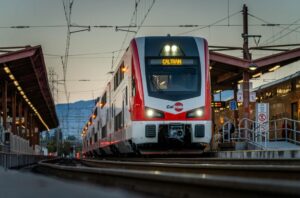By Sam Sargeant, AICP, Associate Editor, October 23, 2024
On September 21, Caltrain launched its new electrified mainline service, transforming the 161-year-old San Francisco to San Jose rail corridor from diesel to zero-emission trains. Caltrain celebrated the launch of the new trains and a new 104-train weekday schedule with community celebrations in the 20 cities along the corridor with tens of thousands in attendance.


Over a decade in the making, Caltrain Electrification was a $2.44 billion project that included constructing overhead wire and power substations, installing new signaling and communications infrastructure, and acquiring American-built Stadler bilevel electric trains. The benefits to customers are significant, with faster and more frequent service (15–20-minute service during peak hours), doubling of weekend service, and onboard amenities like fast Wi-Fi, plugs at every seat, and real-time arrival screens. Offboard, cities along the Caltrain corridor will enjoy quiet, clean rail service through their communities. In fact, annual emissions will be reduced by 250,000 metric tons, equivalent to taking 55,000 gasoline-burning cars off the road.
Caltrain Electrification was fully funded through the efforts of federal, state, and local partners that helped secure funding. These included federal Capital Investment Grant dollars, State funds, including a significant investment by California High-Speed Rail, and regional and county-level funding. In the future, the Caltrain mainline will be part of the “Blended System” with high-speed rail, which is one reason why 25,000-volt overhead power was chosen for the line.
Stadler US, Inc. built the trains at its Salt Lake City, Utah facility. After they were assembled, they were sent to a federal test facility in Pueblo, Colorado. The trains were tested for eight months at high speeds under various conditions as required by the Federal Railroad Administration. Evaluated factors included braking, propulsion, ride quality, noise and vibration, door operation, and Positive Train Control and electromagnetic interference systems. The trains were then deployed for over one thousand miles of travel before being certified for passenger service.
Caltrain’s electrification project and new schedules are expected to accelerate ridership and revenue recovery post-pandemic. In the first few weeks of service, ridership trends look positive, with data from the first full month of service (October) anticipated in mid-November.


Sam serves as Director of Strategy and Policy for Caltrain. Prior to joining the railroad’s executive team, he served as Interim Vice President of Government Affairs, Director of Strategy, and Deputy Chief of Staff for Capital Metro in his hometown of Austin, Texas. A planner and lawyer by training, Sam holds bachelor and law degrees from Boston University.
